
The Dublin Area Rapid Transit system is an electrified commuter rail railway network serving the coastline and city of Dublin, Ireland. The service makes up the core of Dublin's suburban railway network, stretching from Greystones, County Wicklow, in the south to Howth and Malahide in north County Dublin. The DART serves 31 stations and consists of 53 route kilometres of electrified railway, and carries in the region of 20 million passengers per year.

Rail transport in Ireland is provided by Iarnród Éireann in the Republic of Ireland and by Northern Ireland Railways in Northern Ireland.

Heuston Station also known as Dublin Heuston, is one of Dublin's largest railway stations and links the capital with the south, southwest and west of Ireland. It is operated by Iarnród Éireann (IÉ), the national railway operator. It also houses the head office of its parent company, Córas Iompair Éireann (CIÉ). The station is named in honour of Seán Heuston, an executed leader of the 1916 Easter Rising, who had worked in the station's offices.
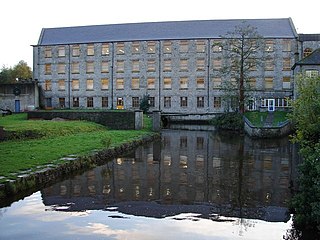
Celbridge is a town and townland on the River Liffey in County Kildare, Ireland. It is 23 km (14 mi) west of Dublin. Both a local centre and a commuter town within the Greater Dublin Area, it is located at the intersection of the R403 and R405 regional roads. As of the 2016 census, Celbridge was the third largest town in County Kildare by population, with over 20,000 residents.

Straffan is a village in County Kildare, Ireland, situated on the banks of the River Liffey, 25 km upstream of the Irish capital Dublin. As of the 2016 census, the village had a population of 853, a nearly two-fold increase since the 2006 census.
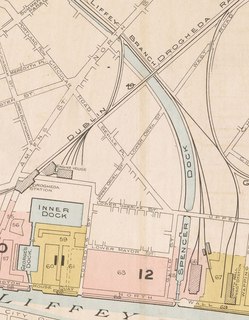
Spencer Dock is a former wharf area, close to where the Royal Canal meets the River Liffey, in the North Wall area of Dublin, Ireland. As of the 21st century, the area has been redeveloped with occupants of the Spencer Dock development including the Convention Centre Dublin, PricewaterhouseCoopers' Irish headquarters, Credit Suisse and TMF Group. The Central Bank of Ireland and NTMA have offices in the nearby Dublin Landings development.

Cabra is an inner suburb on the northside of Dublin city in Ireland. It is approximately 2 kilometres (1.2 mi) northwest of the city centre, in the administrative area of Dublin City Council. It was commonly known as Cabragh until the early 20th century. Largely located between the Royal Canal and the Phoenix Park, it is primarily a residential suburb, with a range of institutions and some light industry. Cabra is served by bus, tram and mainline rail; it lies across Navan Road, one of the main roads from central Dublin to the orbital motorway.
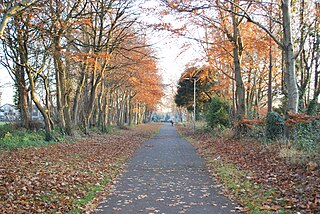
Coolmine is a primarily residential suburb of Dublin, Ireland, in the jurisdiction of Fingal. It is also a townland in the civil parish of Clonsilla.
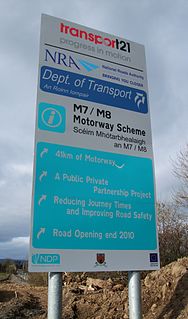
Transport 21 was an Irish infrastructure plan, announced in November 2005. Its aims were to greatly expand Ireland's transport network. A cost estimate of €34 billion was attached to the plan at the time.
Ardclough, officially Ardclogh, is a village and community in the parish of Kill, County Kildare, Ireland. It is two miles (3 km) off the N7 national primary road. It is the burial place and probable birthplace of Arthur Guinness, who is said to have returned to the maternal homestead of the Reads at Huttonread to give birth in the tradition of the time.

The Belfast–Newry line operates from Lanyon Place station in County Antrim to Newry in County Down, Northern Ireland. The manager for this line is based at Portadown railway station, although the line extends to the border to include the Scarva and Poyntzpass halts and Newry. Newry is on the fringe of the network, being the last stop before the border with the Republic of Ireland. The line follows the route of the northern half of the main Dublin–Belfast line, with the exception of calling at Belfast Great Victoria Street.

Caragh or Carragh is a village in County Kildare, Ireland. It is located on the R409 regional road between the River Liffey and the Grand Canal and is located 6.1 km north-west of Naas. The village is also 7.9 km from Clane and 10.6 km from Newbridge.
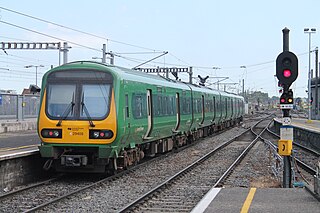
The Dublin Suburban Rail network, branded as DART/Commuter, is a railway network that serves the city of Dublin, Ireland, most of the Greater Dublin Area and outlying towns. The system is made up of five lines:

Ongar is an outer western suburb of Dublin, Ireland. Developed on a greenfield basis since 2001, it comprises the townlands of Castaheany (northerly) and "Hansfield or Phibblestown" (southerly), within the ancient Barony of Castleknock, County Dublin. It is close to Castleknock, Blanchardstown and Clonsilla. The development has a number of amenities on the main street, there are several schools in the area, and the nearby railway line at Hansfield railway station connects to the Luas Green Line and ultimately the N3 national route / M3 motorway. Employers in the nearby business parks and "Greater Blanchardstown" include Intel, Hewlett Packard, IBM, Kepak and eBay.
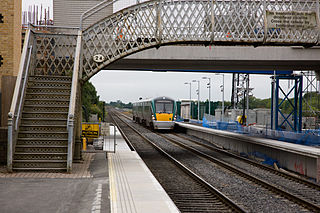
Hazelhatch and Celbridge railway station serves the area around Hazelhatch in South Dublin and the large town of Celbridge in neighbouring County Kildare, Ireland. Because of its distance from Celbridge town, a feeder bus is provided to transport people to and from the station. The county boundary between Dublin and Kildare runs directly through the station.

The Dublin–Cork Main Line is the main InterCity railway route in Ireland between Dublin Heuston and Cork Kent. In 2018, 3.46 million passengers travelled on the line, a 10% increase from 2017 figures.

Leixlip is a town in north-east County Kildare, Ireland. Its location on the confluence of the River Liffey and the Rye Water has marked it as a frontier town historically: on the border between the ancient kingdoms of Leinster and Brega, as an outpost of The Pale, and on Kildare's border with County Dublin. Leixlip was also a civil parish in the ancient barony of Salt North.
Lexilip is a civil parish and a townland located in the north-eastern corner of County Kildare, Ireland. The civil parish is mainly in the ancient barony of Salt North with a small part in the neighbouring barony of Newcastle. It is centred on the town of Leixlip. In geology, the parish rests on a substratum of limestone, and contains chalybeate springs. It lies at the confluence of the River Liffey and the Rye Water.
Carpenterstown is a townland in the civil parish of Castleknock. The civil parish is part in the ancient barony of Castleknock. In geology, the townland rests on a substratum of limestone and comprises 166 statute acres, the whole of which is arable land.

















